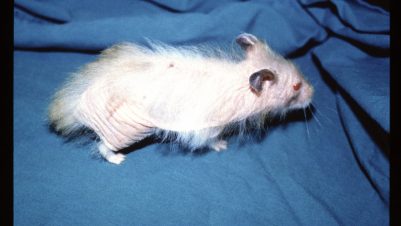- Rare and unique to the cat (Miller et al., 2013). Can be considered a cutaneous marker for an underlying malignancy (Hnilica, 2011).
- Associated in most cases with a pancreatic malignant tumour, either acinar or pancreatic duct. In these cases metastasis has often occurred at the time of diagnosis. Bile duct carcinoma has also been described, and most recently a single case was reported of a metastasising intestinal carcinoma (Grandt et al., 2015).
- Occurs often in cats older than 10 years.
- No sex or breed predilection.
Clinical signs
- Rapid in onset (weeks to a few months).
- Alopecia begins ventrally and then spreads to the limbs, sparing the head in most cases.
- Focal areas of erythema with a characteristic shiny and glistening skin.
- There may be crusting and waxy debris associated with secondary Malassezia, leading to pruritus.
- Loss in weight and general signs of illness associated with the underlying malignant tumour.
Differential diagnosis
(Hnilica, 2011)
- Hyperadrenocorticism.
- Fleabite hypersensitivity.
- Dermatophytosis.
- Food allergy.
- Cutaneous drug eruption.
- Telogen de uxion.
- Alopecia areata.
Diagnosis
- History, physical examination. The distinctive appearance of the signs in an older cat, which are sudden in onset and with easy epilation of the skin, are all highly suggestive.
- Rule-out of differentials.
- Skin biopsy. Acanthosis, parakeratosis, follicular atrophy and lack of trichilemmal keratin (Miller et al., 2013).
- Radiography and ultrasonography may enable a diagnosis, but not always as masses may be too small to visualise.
- Exploratory laparotomy.
Treatment
- Appropriate treatment of secondary pyoderma and Malassezia dermatitis to control pruritus.
- Supportive care.
- Complete removal of an underlying malignant tumour would be the theoretical treatment of choice. Curative surgery has not been reported although there was a temporary improvement in one cat before return of clinical signs with tumour recurrence (Tasker et al., 1999).
Prognosis
- The prognosis is very poor as many underlying tumours have metastasised by the time the diagnosis is made.
- Most cases die within eight weeks of diagnosis with euthanasia frequently necessary.
- Illustrations by courtesy of David Lloyd, Royal Veterinary College Dermatology Group.
References and
further reading
- Grandt, L-M, Shroeder, S., Kochlerk, K. and others (2015) Feline paraneoplastic alopecia associated with metastasizing intestinal carcinoma. Journal of Feline Medicine and Surgery 1 (2).
- Hnilica, K. A. In: Small Animal Dermatology – A Color Atlas and Therapeutic Guide, 3rd edition, pp304-309. Elsevier, 2011.
- Miller, W. H., Grif n, C. G., Campbell, K. A. In: Muller and Kirk’s Small Animal Dermatology, 7th edition, pp568-569. Elsevier, 2013.
- Tasker, S., Griffon, D. J., Nuttall, T. J. and others (1999) Resolution of paraneoplastic alopecia following surgical removal of a pancreatic carcinoma in a cat. Journal of Small Animal Practice 40 (1): 16-19.







-1628179421-401x226.jpg)



